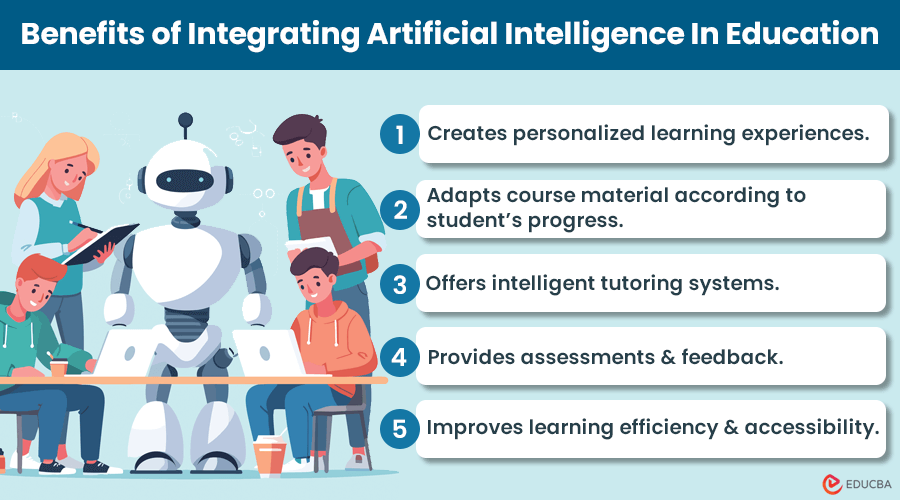
Why There is a Need For Artificial Intelligence in Education?
Artificial intelligence (AI) has become an important part of almost every sector of life. Moreover, AI has significantly impacted the education sector. AI addresses the growing need for learning solutions, like personalized learning according to the strengths and weaknesses of each student. Thus, integrating AI into education helps improve the quality of learning experiences and reaches a larger audience regardless of geographical location. This article mentions the pros and cons of artificial intelligence in education.
Top Benefits of Artificial Intelligence in Education
The following are some of the advantages of AI technology in the education sector, especially e-learning platforms.
1. Offers Personalized Learning Experiences
AI algorithms create personalized learning paths using various factors, such as a student’s learning preferences, performance metrics, and pace of progress. With these personalized learning paths, each learner receives materials and content that reflect their requirements.
Moreover, you can receive the latest solutions and guidance since artificial intelligence is highly advanced. Because of this, students can learn and be knowledgeable about the latest information.
2. Adapts Course Material According To Student’s Progress
According to Anna Harris, ESL instructor at California Degree, “AI helps eLearning platforms dynamically adjust difficult course material depending upon the progress of a student. This means that a fast-paced learner is provided with advanced material for better engagement, while a slow learner receives content in simplified language. With this assistance and adaptive learning, students can have a reliable and supportive learning environment. It can help them to progress consistently with the best possible learning methods.”
3. Offers Intelligent Tutoring Systems
“AI-powered tutoring systems can guide you whenever you need it. They focus on the areas where you’re struggling, offering a level of personalization that’s hard to match. With constant access to the latest methods and information, you’re always learning what’s most relevant, without waiting for traditional resources to catch up,” says Aljay Ambos, Head of Marketing at Twixify, an AI rewriting tool that enhances student output by humanizing it.
Moreover, since artificial intelligence is highly advanced, you can receive the latest solutions and guidance. Because of this, students can learn and be knowledgeable about the latest information.
4. Provides Assessments And Feedback
AI helps the students get immediate guidance and feedback by responding to queries and providing detailed explanations for concerns.
Rudy Bush, Founder at Wiringgerman, says, “Assessment and feedback are central elements of the learning process. However, manual evaluation of tests and assignments is time-consuming for learners and often results in delayed feedback. Using AI, students can streamline their feedback and learning process. It will also save a lot of the time it might take for a manual assessment. AI-powered tools are also helpful for educators in grading quizzes, assignments, and exams with instantaneous feedback. They will save learners time and ensure uniform evaluation criteria for students’ work to promote consistency and fairness.”
5. Improves Learning Efficiency
Ozzi Jarvinen, founder of Iglu, said, “AI can help learners who face difficulty in their learning. For instance, AI may help students whose first language is not English by creating customized learning experiences based on each student’s unique learning pace and style. Furthermore, it can improve communication between teachers and students by offering instant reviews of student’s performance. This allows teachers to identify areas where a learner is struggling and help them to manage those issues in a more effective way.”
6. Enhances Accessibility
Kartik Ahuja, Marketing Manager at LegalOn, says, “AI brings new forms or ways for teachers, students and computers to interact smoothly. It does so by different means, such as sketches, voice, gestures, and other human modes of communication. These new forms support students with disabilities and also those that need various learning situations. They also provide additional support for students to work on collaborative assignments. Moreover, it can also assist teachers with complicated classroom routines. With such accessibility, AI ensures that no one is left behind and everyone receives the knowledge they need in the best way possible.”
Challenges and Potential Drawbacks of AI in Education
While there are many benefits of using AI in modern education, some challenges also need to be addressed. Here are a few potential drawbacks of artificial intelligence in education, especially for eLearning.
2. Reduces Human Interaction
Vicky Cano, Chef & Recipe developer at Mealfan, says, “The introduction of AI in a classroom may reduce human interaction, a crucial part of the learning process. Reduction of face-to-face communication can negatively impact student’s social skills development. Moreover, without human interaction, it will be challenging for students to understand complex concepts because AI cannot fully understand and address students’ cultural and emotional differences.
3. Technical Difficulties
AI-based systems can have technical difficulties just like any other technology. These can disrupt the learning process, leading to the loss of valuable time. More importantly, if an AI system crashes during a crucial assessment, it could negatively affect a student’s grades.
Final Thoughts
AI is the latest technology with many pros and cons of artificial intelligence in education. It streamlines the learning process but has challenges and drawbacks. It is important for students and teachers to wisely use this technology, considering all challenges so that they can address them.
Adopting appropriate measures to address these challenges can help learners overcome them and enhance their learning experience. With the right support and training, navigating the AI learning journey can lead to success.
Recommended Articles
We hope this article on “Pros and Cons of Artificial Intelligence in Education” was informative and helpful. To learn more about related topics, refer to the articles below.

